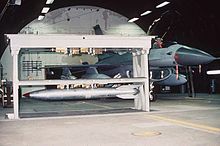|
Hardened aircraft shelter
  A hardened aircraft shelter (HAS) or protective aircraft shelter (PAS) is a reinforced hangar to house and protect military aircraft from enemy attack. Cost considerations and building practicalities limit their use to fighter size aircraft. BackgroundHASs are a passive defence measure (i.e., they limit the effect of an attack as opposed to active defences, such as surface-to-air missiles, which aim to prevent or at least degrade enemy attacks.) The widespread adoption of hardened aircraft shelters can be traced back to lessons learned from Operation Focus in the 1967 Arab–Israeli Six-Day War, when the Israeli Air Force destroyed the unprotected Egyptian Air Force, at the time the largest and most advanced air force in the Arab world, at its airfields’ airbases.[citation needed]  As with many military items, whether structures, tanks or aircraft, its most prolific use was during the Cold War. NATO and Warsaw Pact countries built hundreds of HASs across Europe. In this context, hardened aircraft shelters were built to protect aircraft from conventional attacks, as well as nuclear, chemical and biological strikes. NATO shelters, built to standard designs across the continent, were designed to withstand a direct hit by a 500 lb (226 kg) bomb, or a near miss by a larger one (i.e., 1,000 lb+). In theory, HASs were also built to protect aircraft in a nuclear strike; however, the effect of such an attack on airfield taxiways, runways, support facilities and personnel would have made any retaliatory mission extremely difficult, and subsequent return and rearming almost impossible. In the post-Cold War era, the value of the HAS concept was further eroded by the introduction of precision-guided munitions (PGM).[citation needed] Iraq's HAS hangars were built to a standard somewhat higher than NATO or Warsaw Pact shelters, but nevertheless proved almost useless during the Gulf War.[citation needed] Early attempts to defeat them typically used a "one-two punch" using a TV-guided missile to blast open the doors, followed by bombs tossed in the front. US efforts soon turned to simply dropping a 2,000 lb laser guided bomb on the top, which would easily penetrate the roof and explode within.[citation needed] With that being said, however, NATO hangars would still remain useful against the forces of any enemy as might conceivably engage Europe in an armed conflict in the short term (whose capabilities generally lack precision guidance systems needed to defeat the defensive shield such hangars offer).[citation needed] Advantages
Disadvantages
AlternativesDeployable sheltersKevlar-lined deployable shelters could protect aircraft from bomblets (a common anti-airfield weapon). However, this would provide no protection from PGMs. Dispersal at basesWider dispersal (distance between aircraft) at airbases would decrease the vulnerability of aircraft. This would also force an enemy to increase the number of attacking aircraft greatly, or spend more time over the target. Either way, the effect of airfield defences would take a heavy toll on the aggressor. However, like HAS, dispersal can be expensive, requiring massive construction of hardstanding. Defence against enemy special forces is also more difficult. Dispersal between basesDispersing aircraft between many bases (such as satellite landing aerodromes) greatly increases the cost of attacking a given number of aircraft, as measured by the number of attack aircraft required. However, this option similarly increases the defenders' cost of operation and degrades their efficiency. Dispersal to road runwaysDispersal of aircraft to road runways will present the attacker with a multitude of targets which cannot be simultaneously attacked. Survivability is enhanced if the defender also chooses to use mobile tactics, using each highway strip for a limited number of sorties before moving on to another. With penny packets of two to four aircraft at each location, such a tactic increases the difficulty of effective co-ordination, and command and control, it also increases vulnerability to attack from the ground. However, with adequate planning these are not insurmountable problems. Underground hangarsSeveral air forces have used tunnels dug into a mountainside as underground hangars. Sweden: Bas 60 and Bas 90Sweden developed its own alternative during the Cold War. In the late 1950s, the Swedish Air Force introduced the Bas 60 airbase system, which revolved around both the principle of dispersal between bases and dispersal at bases simultaneously. Road runways (highway strips) were also introduced as alternative bases. Bas 60 was primarily a response to the nuclear threat, so in the aftermath of the Six-Day War in 1967, and the introduction of long range attack aircraft, such as the Sukhoi Su-24, the system was further developed into Bas 90. Improvements in the Bas 90 system included construction of short backup runways in the direct vicinity of the airbases, and further dispersion of aircraft positioning and ground operations. The Swedish Air Force Rangers were also raised specifically to counter the threat of infiltrating enemy special forces.[2][3][4][5] See alsoReferences
Sources
External links |